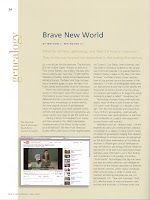Warning! This is a political post! Proceed with caution!
For those who consider genealogy their sacrosanct apolitical “hobby”, completely divorced from those heated issues that are generally considered “politics”, I offer a simple one-word observation.
Nonsense! (
The word that first came to mind is considerably less politically correct, beginning in “B” and ending in “T”)
Sure, genealogy concerns the past and the past is, well, “over and done with” history. Nothing we can do or say today will change that. However, it still makes sense for genealogists to understand (a.) the political decisions of the past that caused things to be the way they were had a profound effect on record-keeping and (b.) that the act of voting actually can have a profound effect on history and how we record it, and, by extension, on what we think of as genealogy.
In other words, when it comes to genealogy, politics –and how you vote – actually matters, whether you like to admit it or not. There’s no sense pussy-footing around the issue: the choices you will make in a few weeks will determine how your grandchildren and great-grandchildren view history and do genealogy.
How can this be? Well, in case you missed it, there are a number of folks running for office this year who think government is way too big and much too intrusive. Specifically, they thought that the 2010 census was an intrusion into Americans’ personal privacy, and several sitting members of Congress advocated not filling it out.
Others espouse the view that the government has no business funding things like libraries and archives. Or public schools. Or universities. Or research.
No big deal, you may counter. What’s the harm? They’re only trying to preserve our precious tax dollars and our “individual liberty”, right? What could go wrong?
In Canada,
the conservative Harper government decided that the long-form census for 2011 was an “intrusion” into Canadians’ personal privacy and decided – against the professional advice of Statistics Canada – to make it “voluntary”. A century from now, do you think that Canadian genealogists will thank the Harper government from protecting them from knowing their ancestors’ religion and ethnicity, thus making their family quest more challenging? After all, no genealogist likes things to be TOO easy…
Then, there were things like the
state sponsored eugenics activities in Vermont in the early 20th century and the development of the
“Plecker lists” in the state of Virginia, to ensure that some folks couldn’t “pass” as white and thus contribute to what Walter Plecker, M.D., the state’s Registrar of Vital Statistics, considered the “mongrelization” of the white race.
At the time, these overtly political acts had far-reaching genealogical consequences in their respective states.
But, of course, that was all a long time ago. Now, times are different and our politics and our genealogy should always be kept completely separate, right?. After all, we’re a “live and let live” kind of people, and surely, there are two sides to every story.
Which brings me to the sorry state of journalism and education these days.
In our attempt to appear “fair”, we’ve thrown elementary logic and the basic principles of science to the winds and adopted the view that all opinions have equal validity. In other words, we’ve been suckered into the vortex of belief that there are two equal, but opposing views, to practically every issue.
Here’s View A, supported by Groups 1, 2 & 3. Here’s opposing View B, supported by Groups 3, 4, & 5. You decide, since both arguments are equally valid.
Problem is – while this may seem, well, - fair and balanced - this isn’t always true. You might espouse the belief that water boils at 300 degrees and that gravity is an optional but unproven “theory”, but those views defy both logic and scientific knowledge and are not views that deserve equal time in the classroom or in the press.
You might truly believe that ancient peoples kept dinosaurs as pets because you always thought the Flintstones story was historical fact, but that doesn’t make it so, and doesn’t mean that it deserves equal time in the classroom.
Just because you are poorly educated does not mean that things you believe about history or science are correct, no matter how fervently you may believe them. Abiding faith in the correctness of your belief is rarely a substitute for facts.
However, politicians who hold similar views often get to decide what gets taught in public schools, how history is presented and what tools the next generation of children will have to help them learn. If you think that electing politicians who think that scientific ignorance is a good thing, and that parents without any education, skills or training will always make the best educational choices for their children, you will have - in some states - lots of political choices this November.
Similarly, electing politicians who believe in closing public records, shutting down libraries and archives as “unnecessary” luxuries, or categorizing some groups of people less “worthy” than others will ensure that future generations of genealogists – if there are any – will have lots of things to keep them busy.
Of course, if you view genealogy mostly as a kind of warm and fuzzy nostalgic activity, devoid of any kind of political or historical context, where YOUR ancestors were always the “good guys”, you will not likely share this political view.
You may even think that the government that keeps the records you need for your “non-political” hobby of genealogy is the “enemy of the people”.
So, when you vote in November, ask yourself if you’re acting in your own best interest - and in the interests of genealogists in general.
Is the guy or gal you’ve chosen really on your side?

















